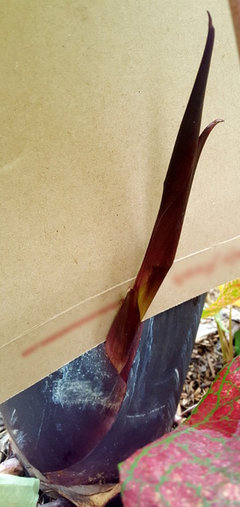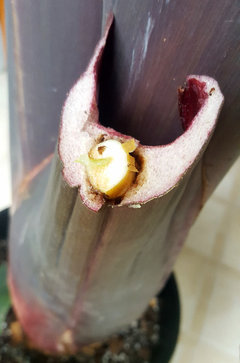Black magic Elephant Ears
LaWanda Teal
6 years ago
last modified: 6 years ago
Featured Answer
Sort by:Oldest
Comments (8)
Related Discussions
WANTED: Black Magic Elephant Ears
Comments (0)I'm interested in one plant of black magic elephant ears. Check out my trade list and let me know if there's something you want in exchange :)...See MoreHAVE: Black Magic Elephant Ears
Comments (5)i would love one of these. please check my page and lmk if we can trade. lmk if you dont see anything you are interested in i might have it but not on list yet. thanks...See Moreblack magic elephant ear yellow
Comments (3)That leaf looks quite concave, like the Colocasia 'Tea Cups'. It also has the dark petioles and leaf blades. They rarely produce seed though, but propagate by runners....See MoreBlack magic Elephant Ears
Comments (1)You'll find aroid specialists in the Aroid Forum. They will want a photo to ID any viral infections....See MoreLaWanda Teal
6 years agoLaWanda Teal
6 years agojay
6 years agolast modified: 6 years agojay
6 years agojay
6 years agolast modified: 6 years ago
Related Stories

LANDSCAPE DESIGNGet Your Garden Moving for a Magical Mood
Use wind, water and wild creatures to add dimension and life to your landscape
Full Story
COLOR11 Reasons to Paint Your Ceiling Black
Mask flaws, trick the eye, create drama ... a black ceiling solves a host of design dilemmas while looking smashing
Full Story
ARTBring In a View Like You’ve Never Imagined
See how art photographers turn a plain white wall into a magical window with a centuries-old camera technique — and how you could try it too
Full Story
HOUZZ TOURSMy Houzz: Fairy-Tale Charm in a Historic Hollywood Landmark
Just a stone’s throw away from Hollywood Boulevard, vine-covered walls hide a magical courtyard and a couple’s condo
Full Story
GARDENING AND LANDSCAPINGLight Your Patio, Extend Your Evening
Cast a magical spell on a summer night with decorative outdoor lighting as sleek or as rustic as you please
Full Story
DECORATING GUIDES25 Design Trends Coming to Homes Near You in 2016
From black stainless steel appliances to outdoor fabrics used indoors, these design ideas will be gaining steam in the new year
Full Story
KITCHEN MAKEOVERSKitchen of the Week: Rich Materials, Better Flow and a Garden View
Adding an island and bumping out a bay window improve this kitchen’s layout and outdoor connection
Full Story
KITCHEN DESIGNKitchen Recipes: Secret Ingredients of 5 One-of-a-Kind Cooking Spaces
Learn what went into these cooks’ kitchens — and what comes out of them
Full Story
GARDENING GUIDESEvocative Plants to Awaken All the Senses
Slip into a garden wonderland that brings more than mere visual delight, by including these grasses, flowers and herbs
Full StorySponsored
More Discussions















tropicbreezent